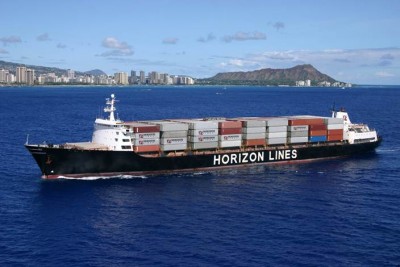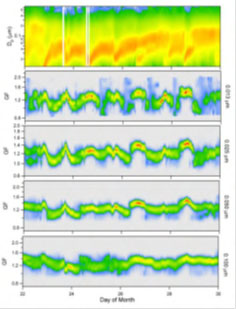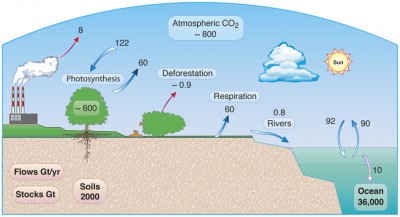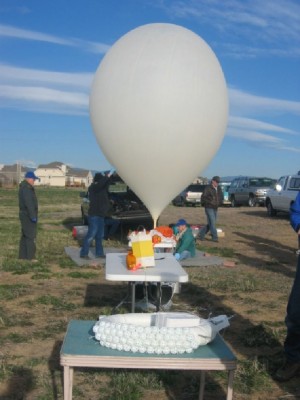Aloha! Mobile Facility to Sail the Pacific; Southern Great Plains Hosts Aerosol and Carbon Campaigns
Published: 31 October 2011
Each year, the ARM Climate Research Facility reviews proposals to use key components of the Facility for extended or intensive field campaigns. The Department of Energy recently announced the selection of new field campaigns that will take place from 2012 through 2013. They include an investigation of marine cloud processes over the Pacific Ocean using the ARM Mobile Facility and aerosol and carbon studies at ARM’s Southern Great Plains site in Oklahoma.

Marine ARM GPCI Investigations of Clouds, or MAGIC. MAGIC places the second ARM Mobile Facility (AMF2) on the Horizon Spirit, a commercial cargo ship operated by Horizon Lines, traversing between Long Beach, Calif., and Honolulu, Hawaii. During approximately 25 round trips between October 2012 and September 2013, the AMF2 will obtain continuous onboard measurements of cloud and precipitation, aerosols, and atmospheric radiation; surface meteorological and oceanographic variables; and atmospheric profiles from weather balloons launched every six hours. MAGIC also includes two two-week intensive observational periods in January and July of 2013. During these periods, additional instruments will be deployed and balloon soundings will be increased to every three hours, providing a more detailed characterization of the state of the atmosphere and its daily cycle during two distinctly different seasons.
Led by principal investigator Ernie Lewis from Brookhaven National Laboratory, the MAGIC science team will use AMF2 data to document the small-scale physical processes associated with turbulence, convection, and radiation in a variety of marine cloud types. These variables are currently very unrealistic in climate models due to a lack of adequate observational data. Because the Long Beach/Honolulu route lies closely along the cross section used for the GPCI, the data collected will provide constraint, validation, and support for the GPCI modeling activities and other associated international modeling efforts. Note:
- GPCI = GCSS Pacific Cross-section Intercomparison, a working group of GCSS
- GCSS = GEWEX Cloud Systems Study
- GEWEX = Global Energy and Water Cycle Experiment, a core project of the World Climate Research Programme.

Aerosol and Carbon Research at the Southern Great Plains Site
New Particle Formation (NPF) Study. This one-month intensive effort will obtain a rich data set to study the formation and evolution of atmospheric aerosols and the impacts of these newly formed aerosols on cloud processes. It will take place during May and June 2013, at the SGP site, when new particle formation events are observed almost daily. Continuous measurements throughout the site will be supplemented with an extensive suite of guest instrumentation at the SGP Guest Instrument Facility. In addition, a small suite of instruments at a satellite location about 100-200 kilometers away will be used to characterize the spatial extent of observed phenomena.
Not to be confused with nucleation—which involves the creation of nuclei and could occur every day—NPF occurs only when those nuclei grow to nanometer-sized particles. The NPF study focuses on the question of what variables determine the growth rate of newly formed particles. Led by principal investigator James Smith from the National Center for Atmospheric Research (NCAR), the NPF science team will use data from this study to develop models for nucleation and growth rates that can be incorporated in atmospheric aerosol models.

This ongoing airborne campaign represents the only long-term effort on record to collect vertical profiles of carbon-cycle gases on a weekly basis, and its objectives are central to related goals of the U.S. Climate Change Science Program. In-kind contributions from NOAA, Lawrence Livermore National Laboratory, University of Colorado-Boulder, and the Carnegie Institution of Washington will support sample analysis. Support for research associated with the campaign will be provided by DOE’s Terrestrial Ecosystem Science program.

The AirCore principle was developed by NOAA’s Earth System Research Laboratory and demonstrated in test flights near Boulder, Colo. To collect full-column profiles above the remote-sensing instruments at the SGP site, the collaborative campaign led by principal investigator Marc Fischer (LBNL) and Colm Sweeney (NOAA-ESRL) will conduct periodic flights demonstrating the AirCore sampling technique, reliable recovery procedures, and on-site sample analysis. The team will then work toward transitioning the sampling and measurement capability to an operational status supporting future scientific research initiatives. As a collaborative activity, significant in-kind resources for this effort are being provided by NOAA-ESRL. Support for research associated with the campaign will be provided by DOE’s Terrestrial Ecosystem Science program.
The ARM Climate Research Facility is a DOE Office of Science user facility. The ARM Facility is operated by nine DOE national laboratories, including .
Keep up with the Atmospheric Observer
Updates on ARM news, events, and opportunities delivered to your inbox
ARM User Profile
ARM welcomes users from all institutions and nations. A free ARM user account is needed to access ARM data.


















